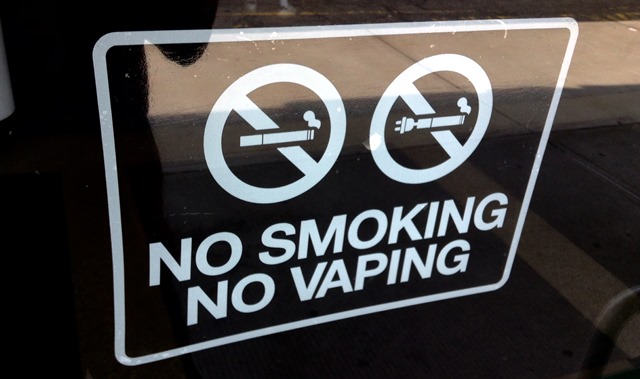Vaping increase raises risk of addiction, tobacco-related disease
Small groups of teens stand idly outside a mall. Small tubular contraptions get pulled out of pockets. Other teens hold them to their mouths. Tiny lights glow at the ends of the devices. A boy exhales a large cloud of what looks like smoke and the girl standing near him asks, “What are you doing?” He responds, “Vaping.”
A survey from June 2016 conducted by NBC found that 24% of high school students said they used electronic cigarettes in the last 30 days. As a result, the President of the American Academy of Pediatrics, Bernard Dryer, concluded that “40% of high school students have tried electronic cigarettes at some point.” Another survey by News Scientist from December 2016 led Surgeon General Vivek Murthy to report, “E-cigarettes went from being rare in 2010 to being the most common tobacco product used by our nation’s youth. Among American high schoolers, vaping reportedly increased by 900% between 2011 and 2015, and this sharp uptick in e-cigarette use places a new generation at risk of addiction to nicotine and tobacco-related disease.”

Most public places, depending on the location, prohibit electronic cigarette smoking indoors.
Although a wide variety of electronic cigarettes exists, their operating mechanisms are similar. The battery in a vaporizer, or electronic cigarette, generates power that goes to the heating chamber which turns the solid vaping material into a gaseous form. The majority of users of vaporizers use e-liquids, but others prefer waxy concentrates and dry herbs. The vapor that is exhaled quickly evaporates into the air.
The Food and Drug Administration, as of August 8, 2016, announced electronic cigarette products would be treated and handled as tobacco products. The sale of electronic cigarette products to minors is forbidden by law. Most public places, depending on the location, prohibit electronic cigarette smoking indoors.
The most frequently asked question about vaping is whether it is safer than smoking. The American Heart Association asserts, “Vaporizers are exponentially less hazardous than cigarettes, and vaping can even help people quit smoking.” The Royal College of Physicians agreed, noting, “The benefits outweigh the risks. Vaping is the first genuine way of helping people quit smoking.”
However, other credible sources disagree. The World Health Organization issued a report suggesting that “vaping can become a gateway for teens and young adults, a gateway to the world of smoking.” Moreover, the American Association for the Advancement of Science said, “A more recent study suggests that vaping has nearly the same impact as cigarettes in terms of suppressing the essential immune system-related genes.”
These health warnings, especially for teens, have aroused the concern of the medical community. Centers for Disease Control Director Dr. Tom Frieden warned, “It’s troubling to see that students are engaging in new risk behaviors, such as using e-cigarettes.” A news article from NBC concluded with Matthew Myers, President of the Campaign for Tobacco-Free Kids, saying, “…Electronic cigarettes and cigars are undermining overall efforts to reduce youth tobacco use and could be luring a new generation of kids into nicotine addiction.” He continued, “All tobacco products are dangerous…we must shore up our efforts to stop this disturbing trend before it climbs higher and turns more young people into lifelong tobacco addicts.”
As noted, varying opinions and facts about electronic cigarettes have been published. Regardless of whose views one accepts, it’s important to remember that minors are prohibited from buying electronic cigarette products, and their use may have negative health consequences.

I am Gabriella Delprete, a senior. I love to read, write, shop, go to movies with friends, and hang out with my family. I also love listening to music,...












Mcdonalds • Feb 1, 2018 at 1:29 pm
Juuls are not nearly as harmful as tobacco so if juuls are just as easy to get as cigarrettes then would you not rather have people consuming the sfaer option? I put the thought to you that people who juul would have instead smoked cigarrettes and so their use of something less harmful than what they could be doing should reduce the amount of consumed carsinogens. Carsinogens like arsenic are readily found in cigarrettes. If you are not aware Carsinogens are the most common catalysts of cancer. Would you rather have more of your students and friends getting cancer? I should hope not. This is not to mention the environmental detriments of cigarrettes and the effects of secondhand cigarrette smoke. So I would like you to think about the pros of people juuling and vaping over cigarrettes. Think also about the fact that if you were to take their juuls and vapes away from them, some of them would then turn to smoking. Pay no mind to the name I have chosen or the email I have given because it has become impossible to voice opinions on things such as this without being persecuted. Thank you for your time and open mindedness if you have read this far. Please consider juuls as an alternative to smoking not as a delinquint activity done by “those people”.
Old McDonald • Feb 15, 2018 at 1:01 pm
Amen
Marvin • Feb 26, 2018 at 3:09 pm
Preach